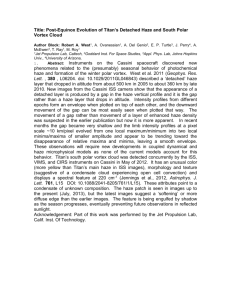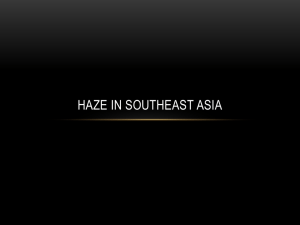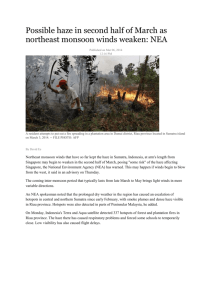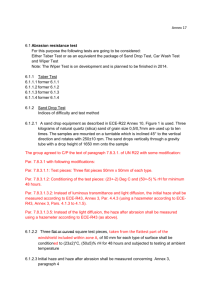www.ijecs.in International Journal Of Engineering And Computer Science ISSN: 2319-7242
advertisement
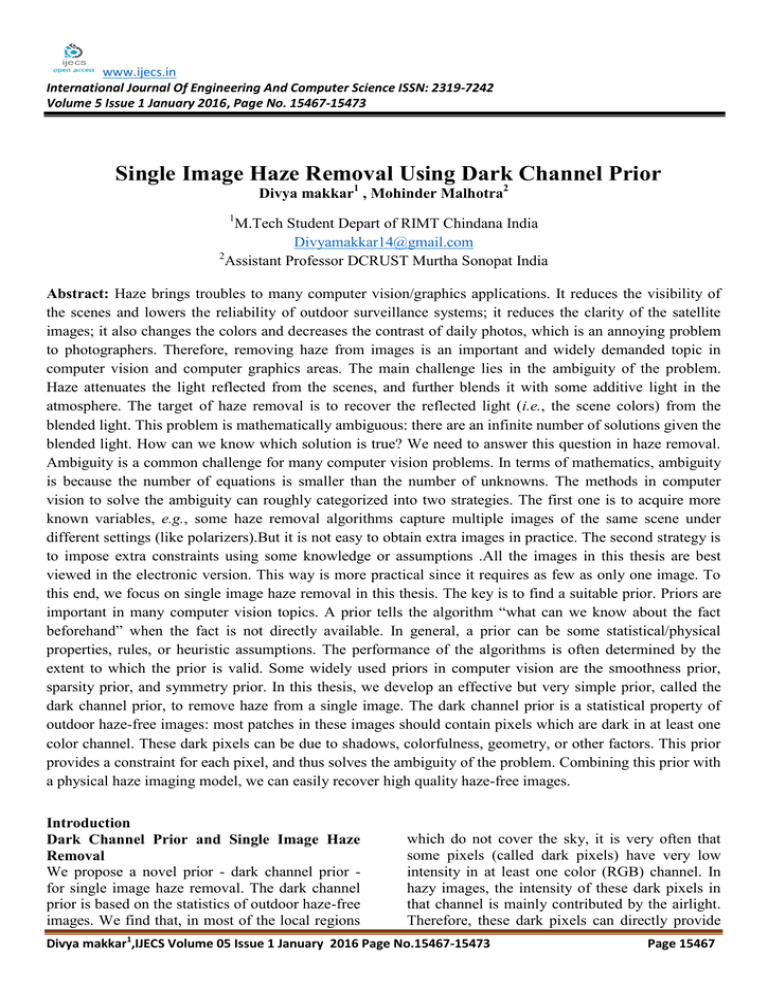
www.ijecs.in International Journal Of Engineering And Computer Science ISSN: 2319-7242 Volume 5 Issue 1 January 2016, Page No. 15467-15473 Single Image Haze Removal Using Dark Channel Prior Divya makkar1 , Mohinder Malhotra2 1 M.Tech Student Depart of RIMT Chindana India Divyamakkar14@gmail.com 2 Assistant Professor DCRUST Murtha Sonopat India Abstract: Haze brings troubles to many computer vision/graphics applications. It reduces the visibility of the scenes and lowers the reliability of outdoor surveillance systems; it reduces the clarity of the satellite images; it also changes the colors and decreases the contrast of daily photos, which is an annoying problem to photographers. Therefore, removing haze from images is an important and widely demanded topic in computer vision and computer graphics areas. The main challenge lies in the ambiguity of the problem. Haze attenuates the light reflected from the scenes, and further blends it with some additive light in the atmosphere. The target of haze removal is to recover the reflected light (i.e., the scene colors) from the blended light. This problem is mathematically ambiguous: there are an infinite number of solutions given the blended light. How can we know which solution is true? We need to answer this question in haze removal. Ambiguity is a common challenge for many computer vision problems. In terms of mathematics, ambiguity is because the number of equations is smaller than the number of unknowns. The methods in computer vision to solve the ambiguity can roughly categorized into two strategies. The first one is to acquire more known variables, e.g., some haze removal algorithms capture multiple images of the same scene under different settings (like polarizers).But it is not easy to obtain extra images in practice. The second strategy is to impose extra constraints using some knowledge or assumptions .All the images in this thesis are best viewed in the electronic version. This way is more practical since it requires as few as only one image. To this end, we focus on single image haze removal in this thesis. The key is to find a suitable prior. Priors are important in many computer vision topics. A prior tells the algorithm “what can we know about the fact beforehand” when the fact is not directly available. In general, a prior can be some statistical/physical properties, rules, or heuristic assumptions. The performance of the algorithms is often determined by the extent to which the prior is valid. Some widely used priors in computer vision are the smoothness prior, sparsity prior, and symmetry prior. In this thesis, we develop an effective but very simple prior, called the dark channel prior, to remove haze from a single image. The dark channel prior is a statistical property of outdoor haze-free images: most patches in these images should contain pixels which are dark in at least one color channel. These dark pixels can be due to shadows, colorfulness, geometry, or other factors. This prior provides a constraint for each pixel, and thus solves the ambiguity of the problem. Combining this prior with a physical haze imaging model, we can easily recover high quality haze-free images. Introduction Dark Channel Prior and Single Image Haze Removal We propose a novel prior - dark channel prior for single image haze removal. The dark channel prior is based on the statistics of outdoor haze-free images. We find that, in most of the local regions which do not cover the sky, it is very often that some pixels (called dark pixels) have very low intensity in at least one color (RGB) channel. In hazy images, the intensity of these dark pixels in that channel is mainly contributed by the airlight. Therefore, these dark pixels can directly provide Divya makkar1,IJECS Volume 05 Issue 1 January 2016 Page No.15467-15473 Page 15467 DOI: 10.18535/Ijecs/v5i1.12 an accurate estimation of the haze transmission. To improve the quality of the resulting transmission map, we develop a soft matting interpolation method. Various experiments show that we can recover a high quality haze-free image and produce a good depth map. Our approach is physically valid and is able to handle distant objects in heavily hazy images. We do not rely on significant variance of transmission or surface shading. The result contains few artifacts.we propose a single image haze removal algorithm using the dark channel prior. We show that the dark channel prior introduces an extra constraint to each pixel, providing an estimated transmission value. Then we develop a method called “soft matting” to refine this transmission map. We further propose a robust method to estimate the atmospheric light A, which is also based on the dark channel prior. We have seen the dark channels of haze-free images. But what does the dark channel of a hazy image look like? We can see that the dark channel of a hazy image is not dark (though we still use the name “dark channel”). The reason is the additive airlight: the dark pixels are brightened when the airlight is added. we also see that the dark channel approximately tells the haze thickness: it is brighter in where the haze is thicker. We show that this effect can be explained by combining the haze imaging equation and the dark channel prior, and the transmission and atmospheric light are estimated accordingly. II.Haze Imaging Model The haze imaging equation is given by : I(x) = J(x)t(x) + A(1 − t(x)). The variables are explained in the following: 1. x = (x, y) is a 2D vector representing the coordinates (x, y) of a pixel’s position in the image. 2. I represents the hazy image observed. I(x) is a 3D RGB vector of the color at a pixel The variables are explained in the following: 1. x = (x, y) is a 2D vector representing the coordinates (x, y) of a pixel’s position in the image. 2. I represents the hazy image observed. I(x) is a 3D RGB vector of the color at a pixel. 3. J represents the scene radiance image. J(x) is a 3D RGB vector of the color of the light reflected by the scene point at x. It would be the light seen by the observer if this light were not through the haze. So we often refer to the scene radiance J as a haze-free image. 4. t is a map called transmission or transparency of the haze. t(x) is a scalar in [0, 1]. Intuitively, t(x) = 0 means completely hazy and opaque, t(x) = 1 means haze-free and completely clear, and 0 < t(x) < 1 means semi-transparent. 5. A is the atmospheric light. It is a 3D RGB vector usually assumed to be spatially constant. It is often considered as “the color of the atmosphere, horizon, or sky”. III.Related Works In computer vision, the methods to handle the ambiguity are roughly on two ways. The first way is to acquire more known variables, reducing the discrepancy between the number of equations and the number of unknowns. In haze removal, this is often by capturing two or more images of the scene. The second way is to use some knowledge or assumptions known beforehand, i.e., priors. The priors impose extra constraints/dependency among the unknown variables. In the following, we review the previous haze removal methods in both categories. We do not discuss the technical details of these methods. Instead, we are interested in how they introduce extra constraints. All the methods are reformulated in a same framework, though they may be expressed in different forms in the original works. We believe that this is helpful to better compare these methods V.Physical Model The haze imaging model is: I(x) = J(x)t(x) + A(1 − t(x)). In this appendix, we provide the physical derivation of this equation. The derivation is mainly following the method in. A.1 Scattering We begin with the micro picture of the phenomenon. The particles in the atmosphere scatter light. “Scattering” means that a particle absorbs a portion of the incident light and radiates Divya makkar1,IJECS Volume 05 Issue 1 January 2016 Page No.15467-15473 Page 15468 DOI: 10.18535/Ijecs/v5i1.12 the absorbed light as a light source. Consider a small volume in atmosphere. According to the total light flux Φ scattered by a small volume is proportional to the incident flux E: Φ(λ) = β(λ)E(λ)ΔV. Here, E is the intensity of the incident light, Φ is the total scattered light flux, ΔV is the volume, β is the total scattering coefficient, and λ is the wavelength of the light, indicating the variables are wavelength-dependent. The total scattering coefficient β(λ) is determined by the particle material, size, shape, and concentration. Scattering is the basic reason for both direct attenuation and airlight. Comparisons with Previous Methods Next we compare with all the state-of-the-art methods in previous works. We show that our method outperforms them in various situations.we compare with the dichromatic method which requires two images taken in different atmospheric conditions. Our resultsis merely from the bottom left image. Though our method uses only one image, the recovered scene appears more natural and visually pleasing. Our depth map has no missing labels in the buildings.we compare with the polarization-based method which requires two polarized hazy images. Our result is from only one of the two images. We can see that our method recovers comparable details and contrast with the polarization-based method. Our result also appear less bluish. Moreover, recent work points out that the polarization-based method is not beneficial, because the polarizer reduces the exposure value and increasesthe noise level. The noise is further increased when the two images are combined. So if we use only one unpolarized image as input, the signal-to noise ratio (SNR) would be much higher.we compare with Kopf et al.’s work which based on given 3D models of the scene. Our result does not require any geometric information. We notice that even with the given depth, their method cannot handle inhomogeneous haze. Because when β is not a constant, the transmission can not be obtained by given Figure. The limitations of our method are mainly due to two reasons: the failure of the dark channel prior, and the invalidity of the haze imaging equation. The dark channel prior is statistically based, so there is a chance that some patches or whole images does not obey this prior. The prior may fail when the scene objects are inherently gray or white, white marble in. In this case, our method may overestimate the thickness of the haze (underestimate the transmission). The recovered colors become more saturated than they should be. Another limitation is that the haze imaging equation may be invalid. It involves two situations: (i): channel-dependent transmission t, and (ii) no constant atmospheric light A. (i): Channel-dependent transmission. In the haze imaging equation, it is assumed that the scattering coefficient β is independent of the wavelength λ. But this is not true when the particles in atmosphere are too small. An example is the Rayleigh scattering: the particles are air molecules instead of dust or water droplet. In this case, the transmission t should be modified as channeldependent tc(x) = e−βcd(x) where the scattering coefficients usually satisfy: βr < βg < βb. And we can modify the haze imaging equation by: Ic(x) = Jc(x) tc(x) + Ac (1 − tc(x)). In Rayleigh Scattering, the blue channel transmission tb is often the smallest. So the distant objects often appears blush. Rayleigh Scattering is also the reason for the blue sky. If we follow the original haze imaging equation to remove haze, the distant objects become bluish Notice that the nearer objects is less influenced. One way to fix this problem is to process each channel independently. We can see that the bluish artifacts is removed. But this modification requires that each channel has its own dark pixels, which is less valid than the dark channel prior in some cases. (ii): nonconstant atmospheric light. The haze imaging equation may also be invalid when the atmospheric light A is nonconstant. We should modify it by: Divya makkar1,IJECS Volume 05 Issue 1 January 2016 Page No.15467-15473 Page 15469 DOI: 10.18535/Ijecs/v5i1.12 I(x) = J(x)t(x) + A(x)(1 − t(x)) Where a(x) depends on the position. This is often due to point light sources like the sun and the street lights at night. The atmospheric light is stronger near the center of a point light source In this case our method may fail because our fixed atmospheric light is not correct in most positions of the image. Figure 1.2: Defocusing on three different positions. The input image and depth map Figure 1.1: Haze removal results (cityscapes). t = e−βd from the given depth. On the contrary, our method does not rely on the constant-β assumption. Our result appears clearer in the cloud-like area. Next we compare with single image methods. we compare with the dark object subtraction method. This method assumes a constant transmission, so it can only remove the haze of the nearest objects.The haze effects in the town is reduced at all because of the nearer trees. The result of this method the becomes better if the image is cropped . But the distant haze still remains. On the contrary, our method can remove the haze in each position we compare our approach with Tan’s visibility maximization method. The results of this method have oversaturated colors. This is because the visibility is maximized only when some pixels’ intensity is brought below zero. On the contrary, our method recovers the scenes without severely changing the colors We also notice the apparent halo artifacts in Tan’s result. This is because the smoothness term in his MRF is not edge-aware. Fattal’s ICA method is the most competitive one. we show that our result is comparable with Fattal’s representative example in his paper. we show that our method outperforms Fattal’s in dense haze. His method is based on local statistics and requires sufficient color information and variance. When the haze is dense, the color is faint and the variance is not high enough for estimating the transmission shows Fattal’s results using the reliable transmission values: the reliable regions are sparse. The transmission is then extrapolated by MRF. But the results after extrapolation are still not satisfactory: some regions are too dark (see the mountains) and some haze is not removed (see the cityscape). On the contrary, our approach is more successful in both cases. This is because Divya makkar1,IJECS Volume 05 Issue 1 January 2016 Page No.15467-15473 Page 15470 DOI: 10.18535/Ijecs/v5i1.12 our dark channel prior provides reliable estimation in much more regions than Fattal’s method. situations of dense haze. Fattal’s method is based on statistics and requires sufficient color information and variance. If the haze is dense, the color is faint and the variance is not high enough for his method to reliably estimate the transmission. Our approach even works for the gray-scale images if there are enough shadow regions in the image. We omit the operator minc and use the gray-scale form of soft matting VII.Conclusion Figure 1.3: Comparison with the 3D-geometrybased method. Left: input. Middle: the result of . Right: our result VI. Experimental Results In our experiments, we perform the local min operator using Marcel van Herk’s fast algorithm whose complexity is linear to image size. The patch size is set to 15 × 15 for a 600×400 Equation and are up to an unknown scaling parameter β. The atmospheric lights in these images are automatically estimated using the method described. As can be seen, our approach can unveil the details and recover vivid color information even in very dense haze regions. The estimated depth maps are sharp and consistent with the input images. we compare our approach with Tan’s work The colors of his result are often over saturated, since his algorithm is not physically based and may underestimate the transmission. Our method recovers the structures without sacrificing the fidelity of the colors (e.g., swan). The halo artifacts are also significantly small in our result. Next, we compare our approach with Fattal’s work Our result is comparable to Fattal’s result 2. In Figure, we show that our approach outperforms Fattal’s in we propose the dark channel prior and a single image haze removal algorithm. The dark channel prior comes from an intuitive observation on outdoor haze-free images. Unlike the heuristic assumptions in previous methods, this prior is based on the image statistics, which is the result of inherent physical properties (illumination, colors, and geometry). This prior provides a robust estimation for each pixel, and thus solves the ambiguity of the problem. Despite of itssimplicity, our haze removal algorithm based on this prior is very effective in various situations. Experiments show that our method outperforms most of the previous works. In we study fast algorithms for haze removal. The challenge is that we need to combine the pixel-wise constraints with spatial continuities, which is usually time-consuming. In the first part of this chapter, we develop an algorithm which reduces the time complex of a linear solver from O(rN ) to O(N ) with a kernel radius r. This discovery is contrary to conventional theories, but we prove it true both theoretically This algorithms allows us to increase the speed by choosing a larger kernel. In the second part of this chapter, we treat the problem as a general edge-aware filtering process and propose a novel guided filter accordingly. This filter voids solving the linear system, and can be computed in O(N) time regardless of the kernel size.It enables a real-time performance of our haze removal algorithm. This filter also exhibits many nice properties. Experiments showthat it is advantageous in various applications including haze removal, in terms of both quality and efficiency. we study the relation between the dark channel prior and the human visual system (HVS). We demonstrate several striking illusion experiments to show that the HVS probably adopts a similar mechanism like the dark channel prior to perceive haze. This study casts new Divya makkar1,IJECS Volume 05 Issue 1 January 2016 Page No.15467-15473 Page 15471 DOI: 10.18535/Ijecs/v5i1.12 insights into the area of human vision research in psychology/phisiology. It also furthersupports the validity of the dark channel prior as a computer vision algorithm, because we are possibly simulating a human visual mechanism. In the future, we plan to study the problem under more general haze imaging situations, e.g., spatially variant atmospheric light or channel-dependent transmission. The problem becomes more illposed and new priors are needed. We are also interested in applying the fast guided filter in more computer vision problems. On the human vision study, we expect to build a model to quantitatively explain the haze perception VIII.References 1. [1] A. Adams, N. Gelfand, J. Dolson, and M. Levoy. Gaussian kd-trees for fast highdimensional filtering. ACM Transactions on Graphics (SIGGRAPH 2009), July 2009. 2. [2] E. H. Adelson. The New Cognitive Neurosciences, 2nd ed, chapter 24, Lightness Perception and Lightness Illusions, MIT Press, 2000. 3. [3] B. L. Anderson and J. Winawer. Image segmentation and lightness perception. Nature, 434:79–83, 2005. 4. [4] V. Aurich and J. Weule. Non-linear gaussian filters performing edge preserving diffusion. In Mustererkennung 1995, 17. DAGM-Symposium, SpringerVerlag, 1995. 5. [5] S. Bae, S. Paris, and F. Durand. Twoscale tone management for photographic look. ACM Transactions on Graphics (SIGGRAPH 2006), July 2006. 6. [6] P. Bhat, B. Curless, M. Cohen, and C. L. Zitnick. Fourier analysis of the 2d screened poisson equation for gradient domain problems. In Proceedings of the European Conference on Computer Vision (ECCV) 2008. 7. [7] W. L. Briggs, V. E. Henson, and S. F. McCormick. A Multigrid Tutorial (2nd). SIAM, 2000. 8. [8] T. F. Chan, S. Osher, and J. Shen. The digital tv filter and nonlinear denoising. IEEE Transactions on Image Processing (TIP), 2001. 9. [9] P. Chavez. An improved dark-object substraction technique for atmospheric scattering correction of multispectral data. Remote Sensing of Environment,1988. 10. [10] CIE. Commission internationale de l’Eclairage proceedings. Cambridge University Press, Cambridge, 1931. 11. [11] D. Coon. Psychology: A Modular Approach To Mind And Behavior. Wadsworth Pub Co, July 2005. 12. [12] T. A. Davis. Direct Methods for Sparse Linear Systems (Fundamentals of Algorithms 2). Society for Industrial and Applied Mathematics, Philadelphia, PA, USA, 2006. 13. [13] Y. Ding, J. Xiao, and J. Yu. Importance filtering for image retargeting. In Proceedings IEEE Conference on Computer Vision and Pattern Recognition (CVPR), 2011. 14. [14] N. Draper and H. Smith. Applied Regression Analysis. John Wiley, 2 edition, 1981. 15. [15] F. Durand and J. Dorsey. Fast bilateral filtering for the display of highdynamic- range images. ACM Transactions on Graphics (SIGGRAPH 2002), 2002. 16. [16] M. Elad. On the origin of the bilateral filter and ways to improve it. IEEE Transactions on Image Processing (TIP), 2002. 17. [17] Z. Farbman, R. Fattal, D. Lischinski, and R. Szeliski. Edge-preserving decompositions for multi-scale tone and detail manipulation. ACM Transactions on Graphics (SIGGRAPH 2008), 2008. 18. [18] R. Fattal. Single image dehazing. ACM Transactions on Graphics (SIGGRAPH 2008), August 2008. 19. [19] R. Fattal, M. Agrawala, and S. Rusinkiewicz. Multiscale shape and detail enhancement from multi-light image collections. ACM Transactions on Graphics (SIGGRAPH 2007), 2007. 20. [20] R. Fattal, D. Lischinski, and M. Werman. Gradient domain high dynamic range compression. ACM Transactions on Graphics (SIGGRAPH 2002), July 2002. 80 132 Divya makkar1,IJECS Volume 05 Issue 1 January 2016 Page No.15467-15473 Page 15472 DOI: 10.18535/Ijecs/v5i1.12 21. [21] P. F. Felzenszwalb and D. P. Huttenlocher. Efficient belief propagation for early vision. In Proceedings IEEE Conference on Computer Vision and Pattern Recognition (CVPR), 2004. 22. [22] C. Franklin. Summed-area tables for texture mapping. ACM Transactions on Graphics (SIGGRAPH 1984), January 1984. 23. [23] M. H. Freeman and C. C. Hull. Optics (11 edition). Butterworth- Heinemann, 2003. 24. [24] W. S. Geisler and D. Kersten. Illusions, perception and bayes. Nature Neuroscience, 25. [25] A. L. Gilchrist. Seeing Black and White. Oxford University Press, 2006. 26. [26] A. L. Gilchrist and A. Jacobsen. Lightness constancy through a veiling luminance. Journal of Experimental Psychology: Human Perception and Performance, 1983. 27. [27] R. C. Gonzalez and R. E. Woods. Digital Image Processing. Prentice Hall, 2 edition, 2002. 28. [28] L. Grady, T. Schiwietz, and S. Aharon. Random walks for interactive alpha-matting. In Visualization, Imaging and Image Processing (VIIP), 2005. 29. [29] K. He, C. Rhemann, C. Rother, X. Tang, and J. Sun. A global sampling method for alpha matting. In Proceedings 30. IEEE Conference on Computer Vision and Pattern Recognition (CVPR), 2011. K. He, J. Sun, and X. Tang. Single image haze removal using dark channel prior. In Proceedings IEEE Conference on Computer Vision and Pattern Recognition (CVPR), 2009. 31. [31] K. He, J. Sun, and X. Tang. Fast matting using large kernel matting laplacian matrices. In Proceedings IEEE Conference on Computer Vision and Pattern Recognition (CVPR), 2010. 32. [32] K. He, J. Sun, and X. Tang. Guided image filtering. In Proceedings of the European Conference on Computer Vision (ECCV), 2010. 33. [33] K. He, J. Sun, and X. Tang. Single image haze removal using dark channel prior. IEEE Transactions on Pattern Analysis and Machine Intelligence (TPAMI), August 2010. 34. [34] H. Helmholtz. Helmholtzs Treatise on Physiological Optics. Optical Society of America, 1866/1924. 35. [35] E. Hering. Outlines of a Theory of the Light Sense. Harvard University Press, 1874/1964. 36. [36] E. Hsu, T. Mertens, S. Paris, S. Avidan, and F. Durand. Light mixture estimation for spatially varying white balance. ACM Transactions on Graphics (SIGGRAPH 2008), August 2008. 37. [37] E. R. Kandel, T. M. Jessell, and J. R. Sanes. Chapter 27: Central visual pathways. Principles of Neural Science (4 ed.), 2000. 38. [38] J. Kopf, M. Cohen, D. Lischinski, and M. Uyttendaele. Joint bilateral upsampling. ACM Transactions on Graphics (SIGGRAPH 2007), 26, July 2007 39. [39] J. Kopf, B. Neubert, B. Chen, M. Cohen, D. Cohen-Or, O. Deussen, M. Uyttendaele, and D. Lischinski. Deep photo:Model-based photograph enhancement and viewing. ACM Transactions on Graphics (SIGGRAPH Asia 2008), 2008. 40. [40] H. Koschmieder. Theorie der horizontalen sichtweite. Beitr. Phys. Freien Atm, 1924. 41. [41] A. Levin, D. Lischinski, and Y. Weiss. Colorization using optimization. ACM Transactions on Graphics(SIGGRAPH 2004), August 2004. 42. [42] A. Levin, D. Lischinski, and Y. Weiss. A closed form solution to natural image matting. In Proceedings IEEE Conference on Computer Vision and Pattern Recognition (CVPR), volume 1, 2006. [43] C. Liu, W. T. Freeman, R. Szeliski, and S. B. Kang. Noise estimation from a single image. In Proceedings IEEE Conference on Computer Vision and Pattern Recognition (CVPR). Divya makkar1,IJECS Volume 05 Issue 1 January 2016 Page No.15467-15473 Page 15473

